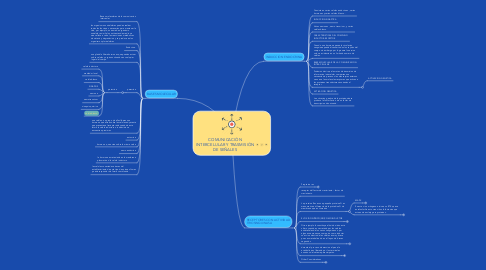
1. BASES MOLECULAR
1.1. Bases moleculares de la comunicacion interceular.
1.2. los organismos unicelulares pueden realizar todas las funciones necesarias para mantener la vida, por ejemplo, una ameba organismo unicelular, asimila los nutrientes de medio se mueve lleva a cabo las reacciones metabolicas de sintesis y degradacion y se produce en los organismos pluricelulares
1.3. Endocrina.
1.4. una gladula libera hormonas que pueden actuar sobre celulas y organos situados en cualquier lugar del cuerpo
1.5. paracrina
1.5.1. paracrina
1.5.1.1. celula inductora
1.5.1.2. mediador local
1.5.1.3. celula blanco
1.5.1.4. SINAPSIS
1.5.1.5. neurona
1.5.1.6. neurotrasmisor
1.5.1.7. sinapsis quimica
1.5.1.8. celula blanco
1.6. una celula o un grupo de ellas liberan una hormona que actua sobre las celulas adyacente que presenten el receptor adecuado de esta forma la celula inductora o indducida se encuentran proximas
1.7. autocrina
1.8. hormona que actua sobre la misma celua
1.9. neuro endocrina
1.10. la hormona es reteniada en la membrana plasmatica d la celula inductora
1.11. las celulas conectadas atraves del establecimiento de este tipo de uniones firmes puede responder de forma coordinada .
2. INDUCCION ENDOCRINA
2.1. Consiste en varias celulas endocrinas , varias hormonas y varias celulas blanco .
2.2. INDUCCION SINAPTICA
2.3. Varias neuronas , neuro trasmisor , y varias celulas blanco
2.4. CARACTERISTICAS DEL COMPLEJO INDUCTOR-RECEPTOR
2.5. Cuando una hormona pasaa la circulacion sanguinea puede alcanzar todos los tejidos del cuerpo sin embargo por lo general su accion solo se evidencia en un limitado numero de celulas.
2.6. BASE MOLECULAR DE LA COMUNICACION INTRA CELULAR
2.7. Podemos decir que las rutas de trasmision de informacion intracelular comparten una secuencia de procesos las mensajeras externos se unen a las moleculas recptoras que activan a las proteinas transductoras asociadas al receptor.
2.7.1. ACTIVACION GENETICA
2.8. ACTIVACION GENETICA
2.9. La activacion geetica de la proteinquinasa proboca la fosforilacion de un factor de transcripcion dnominado.
3. RECEPTORES CON ACTIVIDAD TIROSINQUINASA
3.1. Propteina ras
3.1.1. Situational Analysis / Drivers
3.1.1.1. What is driving us to do this?
3.1.1.2. SWOT Analysis
3.1.1.2.1. Strengths
3.1.1.2.2. Weaknesses
3.1.1.2.3. Opportunities
3.1.1.2.4. Threats
3.1.1.3. Customer Findings - What have we learned from customers?
3.1.2. Competitive Analysis
3.1.2.1. Do we have competitors and threats in these target markets with the proposed offerings?
3.1.2.2. What are our competitors doing and how are they positioning?
3.1.2.3. How do we position against each competitor?
3.1.3. Target Customer(s)
3.1.3.1. Buyer Profile
3.1.3.1.1. Title
3.1.3.1.2. Industry
3.1.3.1.3. Geography
3.1.3.1.4. Business Size
3.1.3.2. Influencer Profile
3.1.3.3. User Profile
3.1.3.4. What do customers want and need?
3.1.3.5. What business problems do each of these customers have?
3.1.4. Customer Segmentation
3.1.4.1. Which customers or sets of customers do we sell to?
3.1.4.2. What are the target market segments that we want to go after?
3.1.4.3. What are the distinct problems for each segment of the market?
3.1.5. Total Available Market
3.1.5.1. New Prospects
3.1.5.1.1. How much of each target segment have we penetrated?
3.1.5.1.2. How much opportunity is available in each target segment?
3.1.5.2. Existing Customers
3.1.5.2.1. Can we up-sell existing customers?
3.2. receptor del factor de crecimiento - factor de crecimiento
3.3. La proteina Ras es una pequeña proteina G es menomerica a diferencia de la protehina G de membrana que es trimetrica
3.3.1. MAPK
3.3.1.1. What are we selling?
3.3.1.2. Product Definition
3.3.1.3. Pricing
3.3.1.4. Packaging
3.3.1.5. Positioning
3.3.2. En esta vi un mitogeno activa a su RTK que se autofosforilia esto crea sitios foforitosina que actuan de anclaje para proteinas.
3.3.2.1. What is the Value Proposition to the Customer?
3.3.2.2. What pain are we solving?
3.4. EL ÓXIDO NITRICO(NO)COMO INDUCTOR
3.4.1. Revenue Forecasts
3.4.1.1. Revenue and P&L Forecast (5 Years)
3.4.1.2. Revenue should be split out quarterly
3.4.2. Cost Analysis
3.4.2.1. Should include a description of the costs in entering this business and profitability analysis
3.4.3. Profitability Analysis
3.4.3.1. P&L for the offer to include gross margin, net income and break even analysis.
3.5. Otro ejemplo lo constituye el óxido nitrico este ultimo cuando es secretado por las celulas endoteliales de los vasos sanguineos o por algunas neuronas se comporta como inductor su accion dentro de las celulas es muy breve pues es metabolizado en el lapso de breves segundos
3.5.1. Sales Strategy
3.5.1.1. Direct Sales Strategy
3.5.1.2. Inside Sales Strategy
3.5.1.3. Channel Sales Strategy
3.5.2. Partner Strategy
3.5.2.1. Channel Strategy
3.5.2.1.1. What 3rd party channels should we consider for reselling this service?
3.5.2.2. Technology Partnerships
3.5.2.2.1. What technology vendors (if any) do we need to work with to execute on this plan?
3.5.2.3. Solutions Partners
3.6. durante el proceso de ereccion el pene la acetilcolina es liberada por los terminales axonicos del sistema parasimpatico
3.6.1. Numbers, budget, waterfall, break-even (cost>leads>trials>deals)
3.6.2. Sales Programs
3.6.3. Accelerated Learning Strategy, Controls, Metrics
3.6.4. Include feedback loops
3.6.5. Include financial metrics (definition of success)
3.6.6. Pipeline reports, etc…
3.7. Other Considerations
3.7.1. M&A?
3.7.2. Risk Analysis & Mitigation

